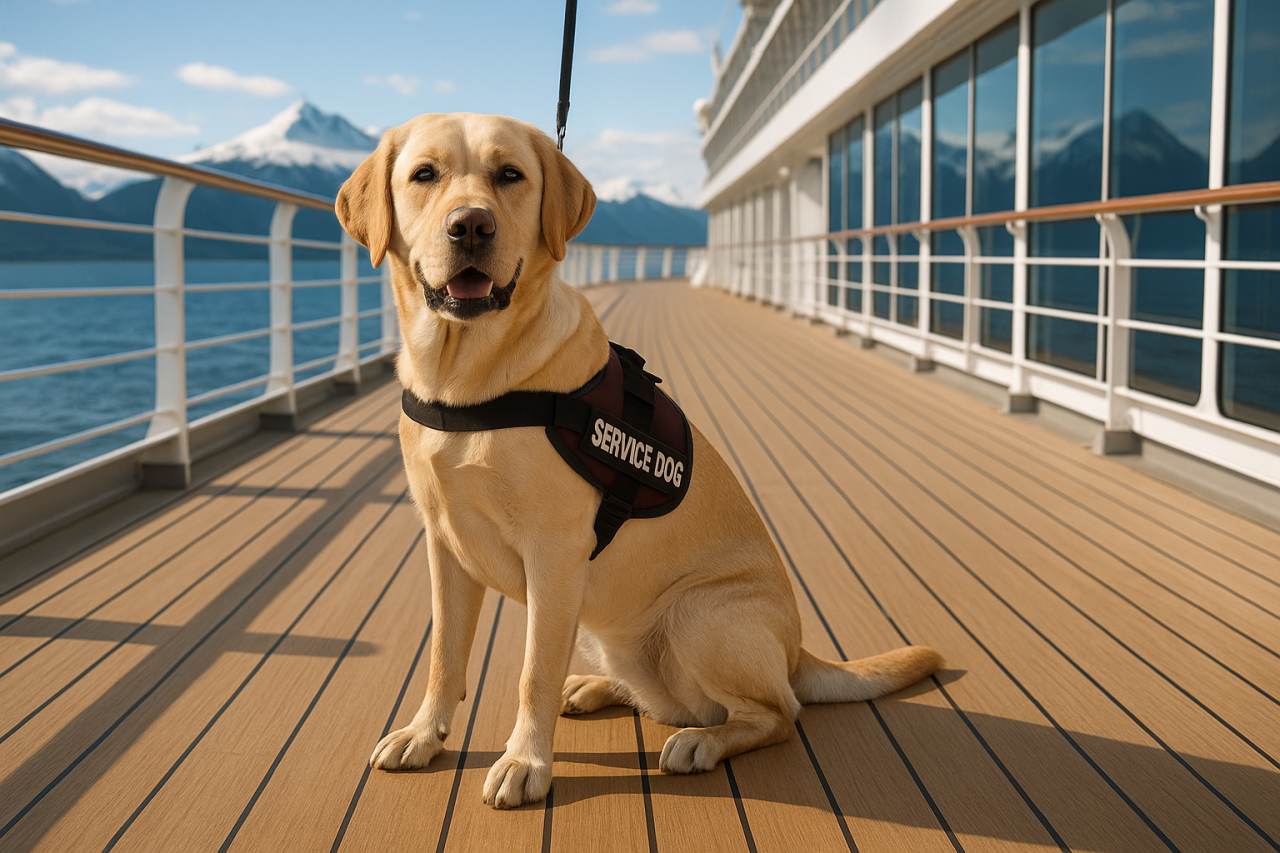Service dog owners have the legal right to experience the cultural exploration and discovery that cruise vacations offer. Under the Americans with Disabilities Act, service animals - defined as dogs individually trained to perform disability-related tasks - can accompany you on cruise ships, providing the independence and safety you need while exploring new destinations. Emotional support animals are not covered under ADA protections and are not permitted on cruise ships.
Questions
Have You Ever Used A Travel Advisor To Book A Cruise?
What To Know: Bringing Your Service Dog On A Cruise
Key considerations for ensuring a smooth cruise experience with your service dog.
- Legal Protections: ADA requirements apply on U.S.-flag ships and foreign-flag ships in U.S. waters, but local laws control access in foreign ports
- Documentation Requirements: All dogs returning to the U.S. need CDC Dog Import Forms, microchips, and must be at least 6 months old - service dogs are not exempt
- Shore Excursion Complexity: Each foreign port has different entry requirements that can restrict service dog access or require additional permits
- Destination Variations: Canada and Alaskan cruises typically have more straightforward requirements compared to Mexican Riviera or Hawaii itineraries
- Expert Assistance: Heather from Flow Voyages has specialized experience as a recreation therapist working with clients who have disabilities and can help navigate these complex requirements using our form to Book A Cruise
Article Index
- Your Legal Rights For Cruising With A Service Dog
- Universal U.S. Re-Entry Requirements
- Destination Complexity: Why Some Cruises Are More Challenging For People Traveling With Service Animals
- Shore Excursion Limitations and Responsibilities
- Onboard Accommodations and Practical Considerations For Taking Your Service Dog On A Cruise
- Travel Advisors Familiar With Service Dogs Makes It Easier
- You Aren't Alone: Cruise Lines Accommodate People With Service Animals Every Day!
Important Disclaimer: Service dog cruise travel involves complex, frequently changing international regulations that vary by destination, cruise line, and specific circumstances. While we strive for accuracy, policies continue to evolve and contain many nuances. We strongly recommend working with an experienced travel advisor who can research the specific requirements for your cruise and ports, working directly with cruise lines on your behalf to ensure compliance with current regulations.
Your Legal Rights For Cruising With A Service Dog
Under the Americans with Disabilities Act, a service animal is specifically defined as a dog that is individually trained to do work or perform tasks for the benefit of a person with a disability. This includes physical, sensory, psychiatric, intellectual, or other mental disabilities, but the tasks must be directly related to the person's disability.
ADA protections apply on U.S.-flag cruise ships and foreign-flag ships while in U.S. waters. However, once you disembark in foreign ports, local laws and regulations control service dog access - ADA protections do not extend to foreign soil. This creates the primary complexity in cruise planning with service dogs.
Service dogs are permitted in all public areas of cruise ships while in U.S. waters, including dining venues, but cannot enter pools, whirlpools, or spas due to health regulations. Major cruise lines provide relief areas and dining accommodations, typically requiring 30 days advance notice to guarantee availability.
Universal U.S. Re-Entry Requirements
As of August 1, 2024, all dogs returning to the United States - including service dogs - must meet CDC import requirements regardless of how briefly they traveled abroad. Service dogs are not exempt from these federal requirements:
- Must be at least 6 months old
- Must be microchipped with a universal scanner-compatible chip
- Must appear healthy upon arrival
- Must have a completed CDC Dog Import Form receipt
These requirements apply whether you visit foreign ports or remain onboard during port stops. The CDC form is valid for multiple entries within six months if traveling only between low-risk countries (U.S., Canada, Mexico).
Destination Complexity: Why Some Cruises Are More Challenging For People Traveling With Service Animals
Understanding why certain cruise destinations present more obstacles for service dog travel helps you make informed choices about your itinerary. The complexity stems from each country's unique import requirements, inspection procedures, and documentation standards that apply regardless of your brief visit duration.
Canada and Alaska: Generally More Straightforward
Canada applies the same import rules to dogs regardless of arrival mode - cruise ship, car, or plane. For most dogs over 3 months, Canada requires proof of current rabies vaccination. However, certified assistance dogs accompanying their user are exempt from presenting a rabies certificate, though carrying documentation proving certification is recommended since Canada Border Services Agency can inspect any animal upon arrival.
Alaska cruises that include Canadian ports still trigger these Canada entry requirements, but since Canada, the U.S., and Mexico are all considered CDC low-risk countries for dog rabies, U.S. re-entry is simplified if you complete the CDC form and your dog hasn't been in a high-risk country in the past six months.
Mexico: Physical Inspection Required
Mexico's current practice centers on SENASICA inspection at arrival. While health certificate requirements can vary by consulate and specific programs, universal requirements include dogs being clinically healthy and proof of treatment for internal and external parasites within six months prior to arrival.
Additionally, dogs returning to the U.S. from Mexico must have screwworm inspection and certification within 5 days prior to U.S. entry, per current APHIS import alerts. This adds veterinary complexity and timing constraints to Mexican itineraries.
Hawaii: State-Specific Protocols
Hawaii's requirements are governed by the Hawaii Department of Agriculture, not cruise line policies. Service dogs can qualify for Direct Airport Release if they meet all state criteria, including two rabies vaccinations, microchip, timely FAVN titer test, and tick treatment within 14 days of arrival, plus extensive pre-arrival paperwork submission.
Airlines and cruise lines may provide escort services to Hawaii Department of Agriculture inspection facilities, but the underlying requirements come from state agricultural authorities. If arriving by ship, confirm inspection logistics well in advance, as most HDOA processing is airport-centric.
Shore Excursion Limitations and Responsibilities
The most challenging aspect of service dog cruise travel involves shore excursions. Cruise lines explicitly state they are not responsible for limitations imposed on service dogs by foreign port authorities or shore excursion providers. You remain fully responsible for:
- Researching and complying with each destination's entry requirements
- Providing all necessary documentation for your service dog
- Arranging care if you choose to disembark without your service dog (though dogs cannot be left unattended)
Ship staff are not required to provide care for your service dog if you disembark alone. Many ports may restrict service dog access entirely or require permits that are difficult to obtain for brief day visits.
Onboard Accommodations and Practical Considerations For Taking Your Service Dog On A Cruise
Major cruise lines have established service dog policies, though specific details vary. Royal Caribbean provides 4-foot by 4-foot relief areas with cypress mulch, with sod available on request for U.S. sailings with 30-day advance notice to their Access Department.
You remain responsible for providing all food, bowls, and care supplies for your service dog throughout the voyage. Some countries restrict importing pet food, especially meat-based products, so consider bringing enough for sea days and verifying port regulations in advance.
When dining onboard, service dogs can accompany you to restaurants and may remain under the table during meals. Cruise lines accommodate this while maintaining health safety protocols for all guests.
Travel Advisors Familiar With Service Dogs Makes It Easier
The complexity of international service dog travel regulations makes professional guidance invaluable. Policies change frequently, vary by specific itinerary, and often contain exceptions or special procedures that aren't immediately obvious from official websites.
Heather Hills from Flow Voyages brings unique qualifications to this challenge. Her background as a recreation therapist working with clients who have disabilities provides practical insight into accessibility needs, while her cruise industry knowledge helps navigate the specific logistics of ship-based travel.
Rather than attempting to interpret complex international regulations independently, Heather can work directly with cruise line accessibility departments and research current requirements for your specific itinerary. This approach helps ensure compliance while focusing your energy on planning the cultural exploration and discovery experiences that make cruising rewarding.
The key lies in understanding that successful service dog cruise travel requires more advance planning than typical cruise bookings, but the investment in proper preparation enables the same discovery-focused experiences that make cruising appealing to travelers who value West Coast cultural values and inclusive exploration.
You Aren't Alone: Cruise Lines Accommodate People With Service Animals Every Day!
While service dog cruise travel involves navigating complex regulations, understanding your rights and working with knowledgeable professionals can make these adventures both accessible and rewarding. The combination of legal protections onboard, advance planning for documentation, and expert guidance for destination-specific requirements creates a framework for successful cruise experiences.
For personalized assistance with service dog cruise planning and current regulatory guidance, consider reaching out to Heather Hills from Flow Voyages, who can help research specific requirements for your itinerary and work with cruise lines to ensure your service dog cruise focuses on discovery rather than documentation stress using our form to Book A Cruise.
Thanks for reading. We hope this was helpful!
Why stop now?
Participate In Our Polls | Ask or Answer A Cruise Question | Contact Heather to Book Your Next Cruise!

